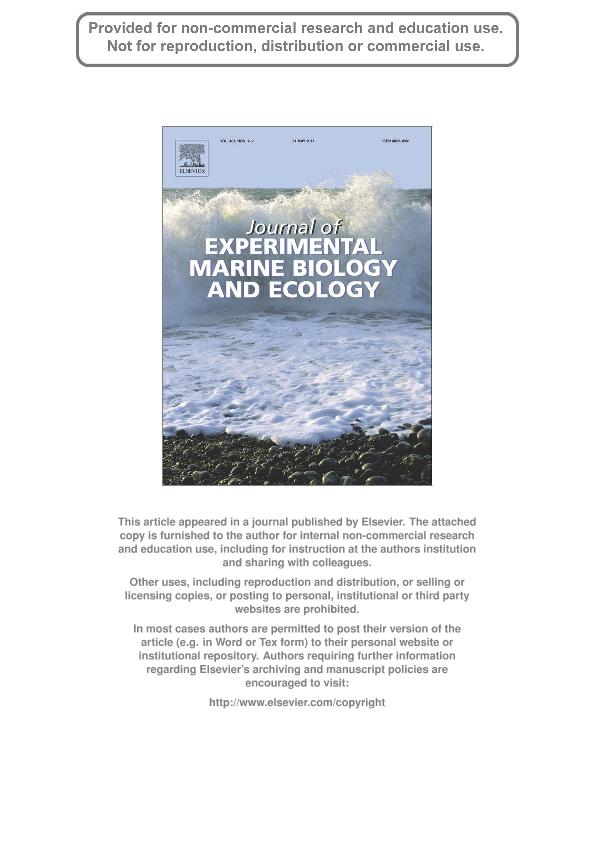Mostrar el registro sencillo del ítem
dc.contributor.author
Mendez Casariego, Maria Agustina

dc.contributor.author
Luppi, Tomas Atilio

dc.contributor.author
Iribarne, Oscar Osvaldo

dc.contributor.author
Daleo, Pedro

dc.date.available
2020-03-26T14:55:54Z
dc.date.issued
2011-05
dc.identifier.citation
Mendez Casariego, Maria Agustina; Luppi, Tomas Atilio; Iribarne, Oscar Osvaldo; Daleo, Pedro; Increase of organic matter transport between marshes and tidal flats by the burrowing crab Neohelice (Chasmagnathus) granulata Dana in SW Atlantic salt marshes; Elsevier Science; Journal of Experimental Marine Biology and Ecology; 401; 1-2; 5-2011; 110-117
dc.identifier.issn
0022-0981
dc.identifier.uri
http://hdl.handle.net/11336/100892
dc.description.abstract
Marshes are considered exporters of organic material, with tides being one of the most studied transport mechanisms. However, animal movements can enhance this energy transport and even, in some cases, import energy to marshes by fecal deposition. In this work, we analyze if Neohelice (Chasmagnathus) granulata, an abundant intertidal burrowing crab that changes its diet between marsh (herbivorous) and tidal flat (deposit feeder) zones and moves between zones during the tidal cycle, enhance energy transfer between marshes and tidal flats by fecal deposition. Given that higher tidal levels increase these movements, two intertidal habitats with different tidal amplitudes were compared (Mar Chiquita Coastal lagoon 37° 40' S -MCCL, max 2. m and San Antonio Bay 40° 46' S -SAB, max 9. m). The seasonal and tidal movements between zones were studied using movement traps. Crabs moving towards each direction were kept in containers to calculate fecal production and the total organic matter (OM) release and OM% of their feces. With these data, a resampling technique was performed to compare with a 3 way ANOVA the net transport of feces seasonally, between zones, in both intertidals. The results showed that the movement of N. granulata enhances the exchange of OM among habitats by fecal deposition between marsh and tidal flats with seasonal variations in its importance. Fecal transport showed differences between locations being 10 times higher in winter and decreasing towards summer in MCCL, while the opposite trend was found in SAB. There were no differences in the OM deposited in each zone in SAB but in MCCL there was 45% more feces deposited in the marsh than in the tidal flat. The fecal OM% is higher in SAB than in MCCL suggesting that biodeposition in SAB, where it can reach 40%OM (surrounding sediment is lower than 2%) could be more important. The fecal production in MCCL is about 80% of the rate of detritus production in the marsh. In conclusion, fecal deposition is a very important input of energy in marsh zones, being crabs an important mechanism in transporting OM mainly towards the marsh zones.
dc.format
application/pdf
dc.language.iso
eng
dc.publisher
Elsevier Science

dc.rights
info:eu-repo/semantics/openAccess
dc.rights.uri
https://creativecommons.org/licenses/by-nc-sa/2.5/ar/
dc.subject
CRABS
dc.subject
ENERGY TRANSFER
dc.subject
FECES
dc.subject
MARSH
dc.subject
MUDFLATS
dc.subject.classification
Ecología

dc.subject.classification
Ciencias Biológicas

dc.subject.classification
CIENCIAS NATURALES Y EXACTAS

dc.title
Increase of organic matter transport between marshes and tidal flats by the burrowing crab Neohelice (Chasmagnathus) granulata Dana in SW Atlantic salt marshes
dc.type
info:eu-repo/semantics/article
dc.type
info:ar-repo/semantics/artículo
dc.type
info:eu-repo/semantics/publishedVersion
dc.date.updated
2020-03-12T15:24:06Z
dc.journal.volume
401
dc.journal.number
1-2
dc.journal.pagination
110-117
dc.journal.pais
Países Bajos

dc.journal.ciudad
Amsterdam
dc.description.fil
Fil: Mendez Casariego, Maria Agustina. Consejo Nacional de Investigaciones Científicas y Técnicas. Centro Científico Tecnológico Conicet - Mar del Plata; Argentina. Universidad Nacional de Mar del Plata. Facultad de Ciencias Exactas y Naturales. Departamento de Biología; Argentina
dc.description.fil
Fil: Luppi, Tomas Atilio. Universidad Nacional de Mar del Plata. Facultad de Ciencias Exactas y Naturales. Departamento de Biología; Argentina. Consejo Nacional de Investigaciones Científicas y Técnicas. Centro Científico Tecnológico Conicet - Mar del Plata; Argentina
dc.description.fil
Fil: Iribarne, Oscar Osvaldo. Universidad Nacional de Mar del Plata. Facultad de Ciencias Exactas y Naturales. Departamento de Biología; Argentina. Consejo Nacional de Investigaciones Científicas y Técnicas. Centro Científico Tecnológico Conicet - Mar del Plata; Argentina
dc.description.fil
Fil: Daleo, Pedro. Universidad Nacional de Mar del Plata. Facultad de Ciencias Exactas y Naturales. Departamento de Biología; Argentina. Consejo Nacional de Investigaciones Científicas y Técnicas. Centro Científico Tecnológico Conicet - Mar del Plata; Argentina
dc.journal.title
Journal of Experimental Marine Biology and Ecology

dc.relation.alternativeid
info:eu-repo/semantics/altIdentifier/url/https://www.sciencedirect.com/science/article/pii/S0022098111000839
dc.relation.alternativeid
info:eu-repo/semantics/altIdentifier/doi/http://dx.doi.org/10.1016/j.jembe.2011.02.035
Archivos asociados
